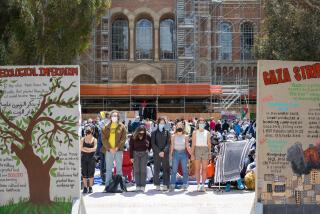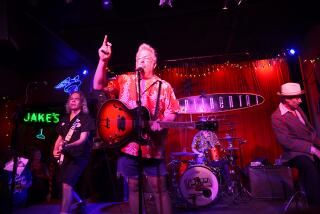The Quest for Nixon Questions
- Share via
I hadn’t been so excited since I caught my first foul ball at an Angel game two summers ago. There it was on the front page of The Times’ Orange County section: a headline reading, “Nixon Library Unveils Plans for ‘Face-to-Face’ Dialogue.”
My mind boggled. Had Richard Nixon really mellowed out in his dotage sufficiently to answer the questions that have been fermenting within his fellow Americans for so many years?
His life passed before me in Technicolor bursts. The Whittier football team. Helen Gahagan Douglas. Alger Hiss. The Checkers speech. The sweat and 5 o’clock shadow in his TV debate with John Kennedy. His campaign for governor of California (which I covered for the Christian Science Monitor) and the promise he didn’t keep after his loss: “You won’t have Nixon to kick around anymore.” The tortured involvement in the Vietnam War. The China opening. The mindless fear of an opponent who could carry only two states. The arrogant accumulation of power (“I’m not a crook.”). The pardon by Gerald Ford. The sense of his omnipresence ever since--as if only a stake through the heart will ever eliminate Richard Nixon from the American political scene.
I remembered vividly trips to pre-Watergate San Clemente as a reporter when I listened with awe to the White House press corps vilify him in private and canonize him in print.
And those days and weeks of sitting glued to the TV set during the Watergate hearings.
I rushed to my desk. Questions. I had to come up with questions to ask him so I would be ready when the Nixon Museum opens next summer. I started listing them feverishly.
First and foremost, of course: Why, oh why, didn’t you destroy those tapes when it was still possible?
Then, as fast as I could write, more questions came racing into my head:
Did you really believe that Helen Gahagan Douglas was a communist? How about Alger Hiss?
Was Checkers really your dog or did you just borrow him/her for that speech?
Who advised you not to shave before the Kennedy TV debate? Where is he buried?
Is it true--or just a liberal canard--that you wear a shirt and tie to bed?
Did you ever visit any of your henchmen in prison? Have you acknowledged any of them since?
Why didn’t Pat write a book called “My Turn”?
What is Henry Kissinger really like?
Do you exchange Christmas gifts with Bob Woodward and Carl Bernstein? How about Gerald Ford?
Things like that I’ve wondered about for years. There are dozens more, but these will give you the idea.
Before I added to my list, it occurred to me that I should find out exactly how these question sessions would work, so I called designer Alex Cranstoun, who was identified in The Times story as the moving force behind the talking Nixon. I caught up with him in New York where his firm is headquartered, and he proved to be an affable, easygoing man.
He explained that he didn’t want to restrict the talking Nixon to a hundred or so stereotyped questions but wanted to open up the question process.
“We considered the possibility of allowing any questions of the visitor’s choosing, but we suspected that most of the Americans who visit the museum won’t be that well-versed in American history so will need a little prompting.”
The prompting, says Cranstoun, will come from four columns of choices, with each column closing in more specifically on the subject. (One broad heading, he assured me, will be “Watergate.”) The questions will be constructed from these prompting columns.
Key words in the question will trigger a computer mechanism that will search among several thousand Nixon quotes for the most appropriate one. This process may take as long as five minutes.
Thus the system will, in a sense, work backward. The designers will start with a broad array of Nixon quotes, then fashion the question columns to elicit the proper quote.
Cranstoun said that if they find questions being asked that are not covered in the bank of responses, they may ask Nixon to add some fresh answers, “but the system we start out with will provide for a large variety of questions.”
He also said Nixon will probably have an opportunity to review the quotes selected “and I can’t say he’ll take them all, but so far there have been very few restrictions placed on us. However, it’s certainly understandable that as long as President Nixon is still around, he and his family are going to want to be cast in the best light possible.”
I ran some of my proposed questions past Cranstoun, and I thought he sounded a little dubious. But he said, rather gallantly, that he would take them under advisement when he made up the list. He granted that the question about the destruction of the tapes--or rather the lack thereof--would probably be a popular one.
The system will also capture the questioner’s image on a screen as well as the President’s. I’ll admit it occurred to me that now that G. Gordon Liddy is out of jail and his road show with Timothy Leary has run its course, he may be holed up in a basement somewhere reviewing these pictures and putting out contracts on people who are asking the wrong questions. He never was one to stand on ceremony.
Oh, well, I’m just going to have to take that chance. This is too good an opportunity to miss, even if the answers are programmed. After all, hasn’t it been ever thus?
More to Read
Go beyond the scoreboard
Get the latest on L.A.'s teams in the daily Sports Report newsletter.
You may occasionally receive promotional content from the Los Angeles Times.










